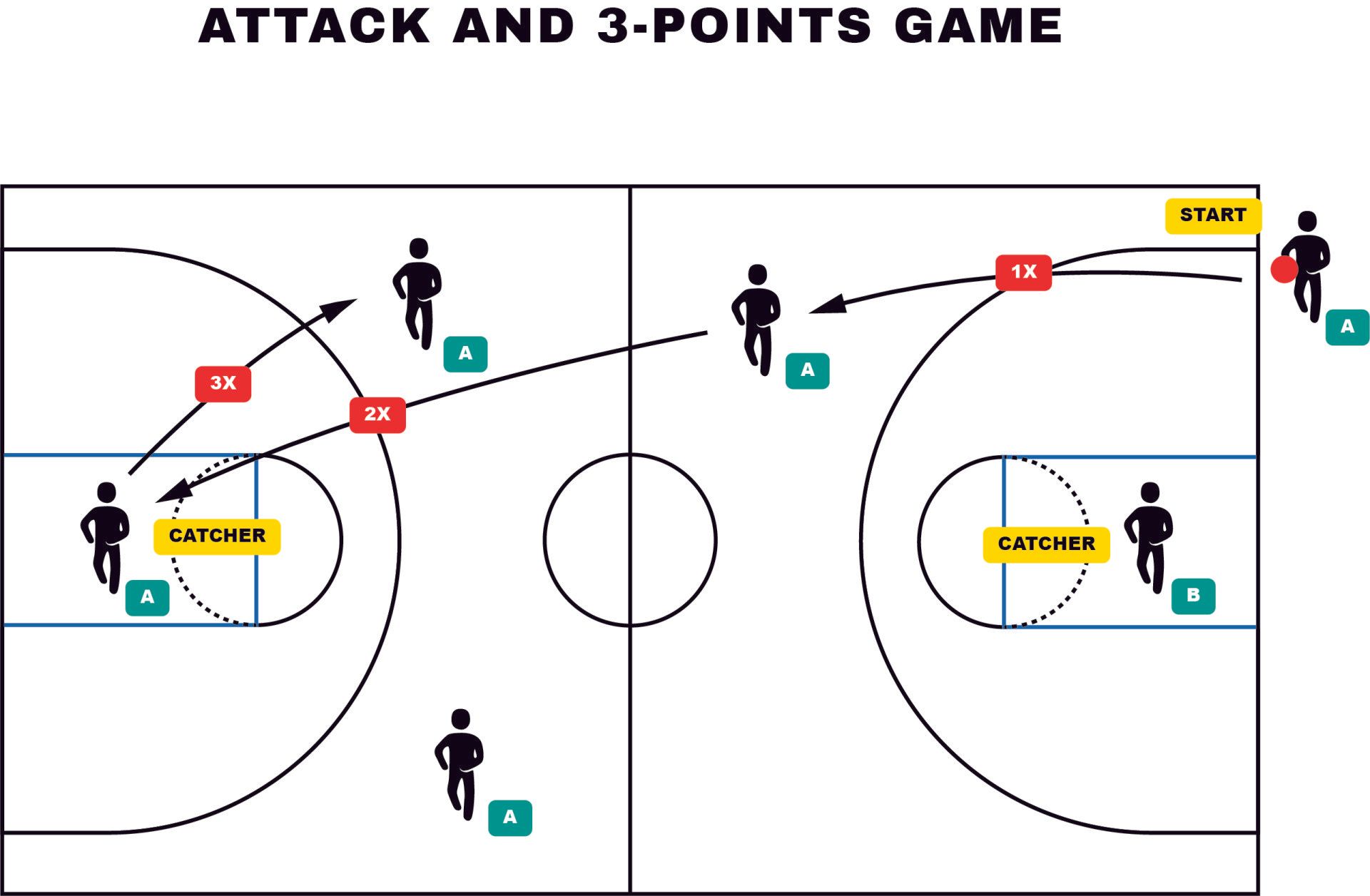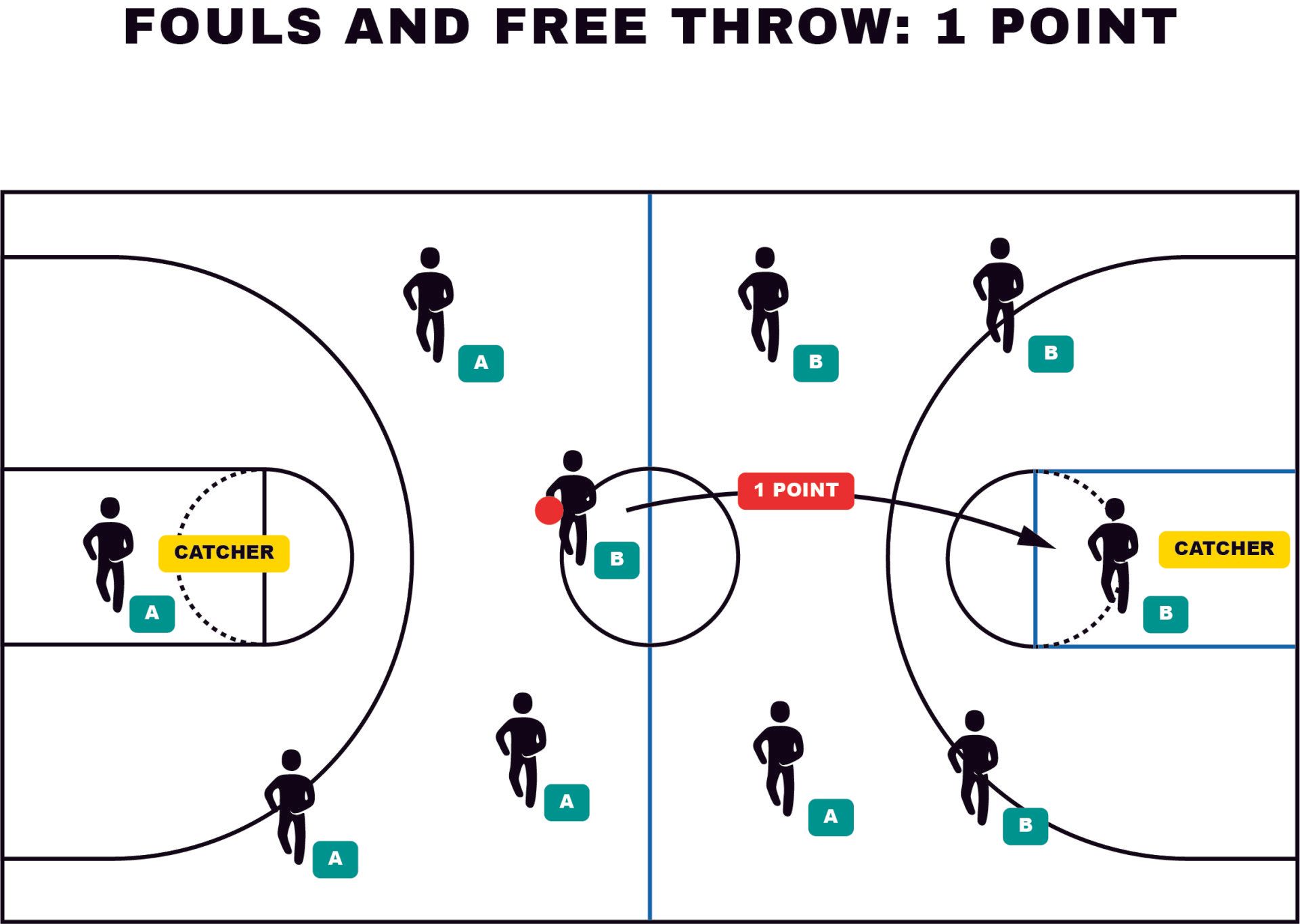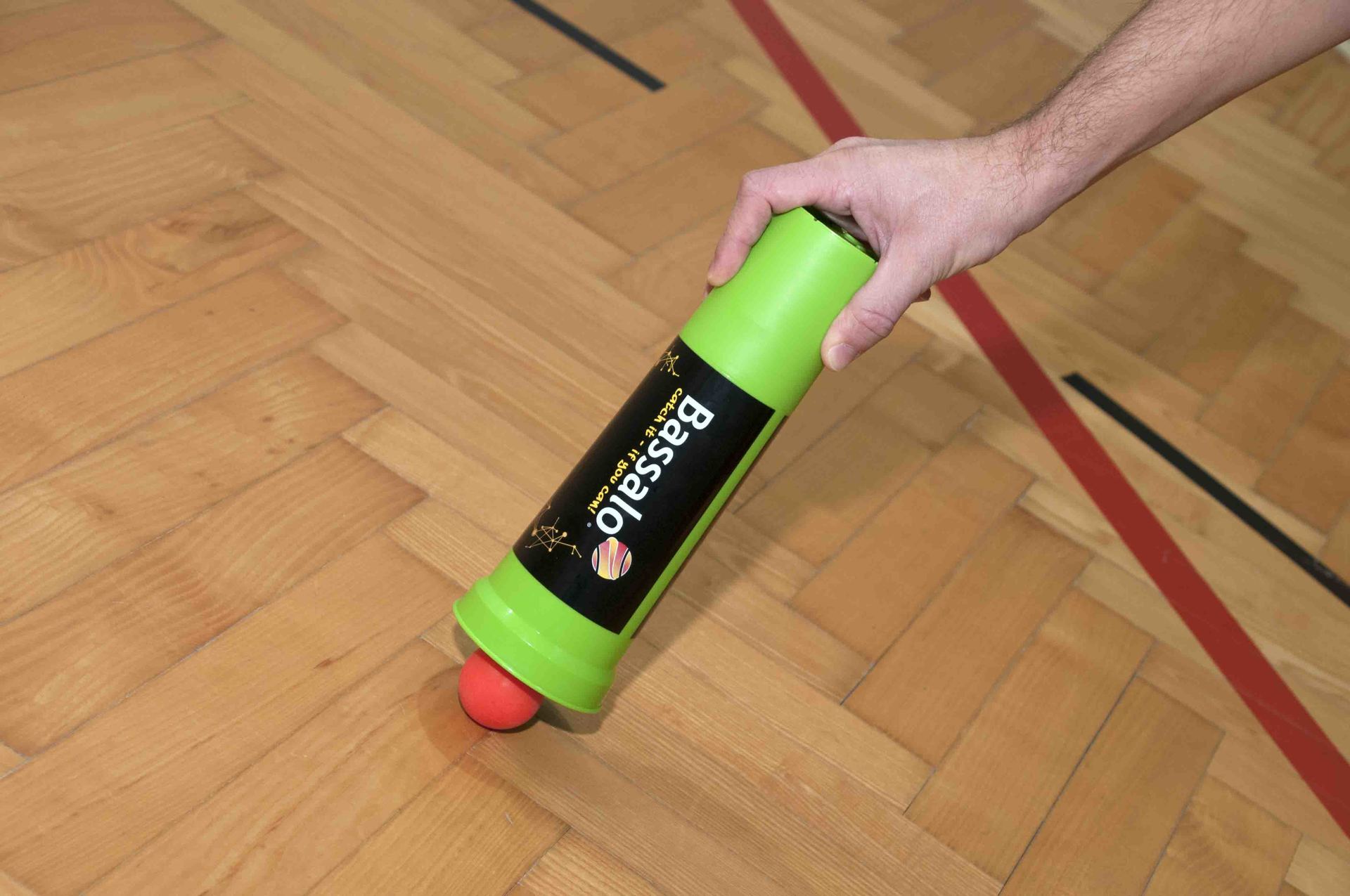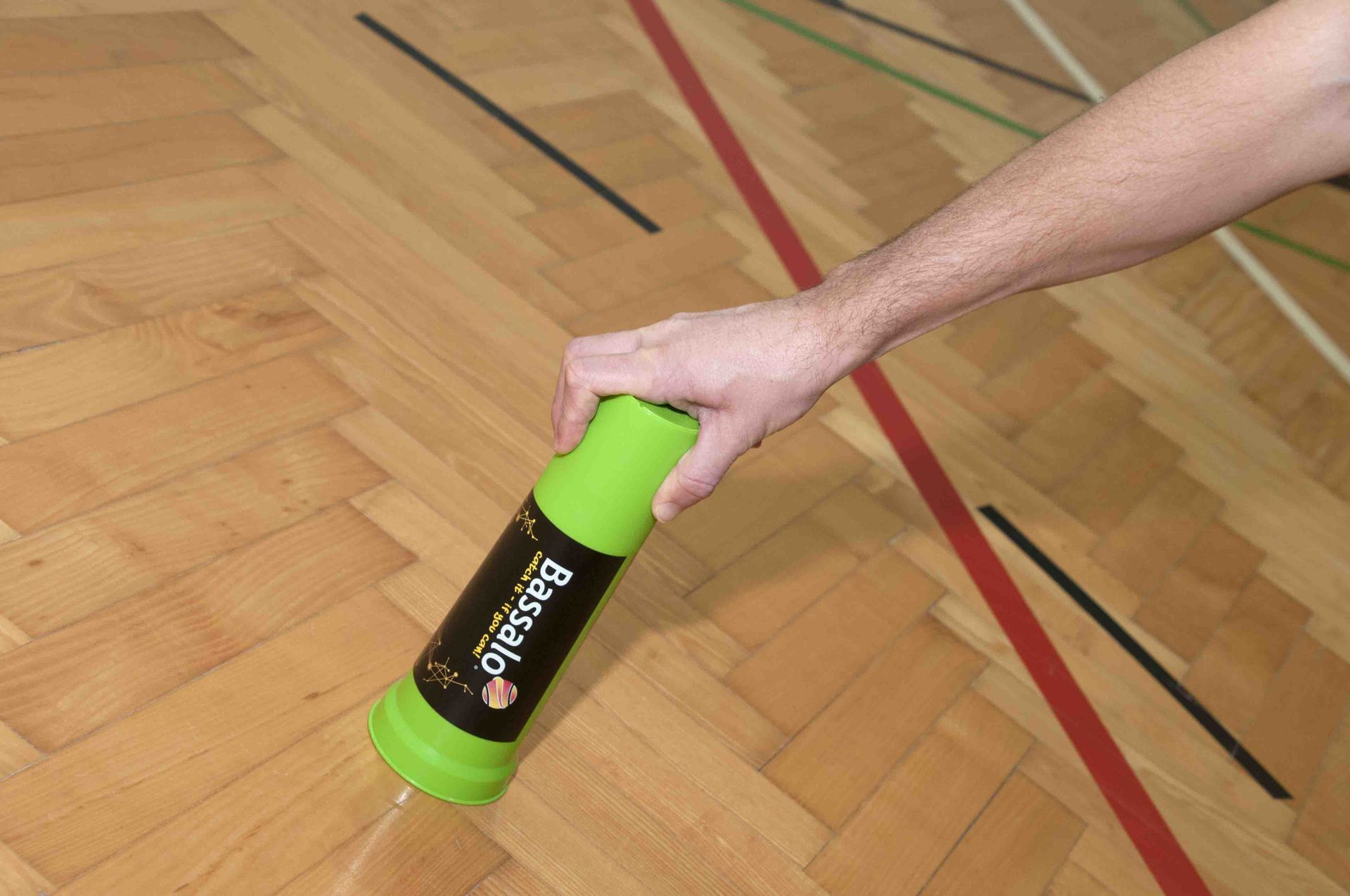1
Key data
- Playing field: Size of a basketball field.
- Number of participants: 10 players (5 vs. 5), two of them female.
- Equipment: 1 Ball and each player a cup (10 cups).
- Duration: 3 x 15 minutes (Schools: 2 x 15 minutes).
- Referee: Yes, one (sport teacher or trainer).
2
Objective of the game
The target of the game is to throw the ball into the opposing "End Zone". The „goal“ is your own teammate, which is acting in this zone as the „Catcher“ (similar to Ultimate Frisbee). The „End Zones“ at Cupball are the Free-Throw-Zones under the baskets.
But before the "Catcher" can score points, the attacking team must catch the ball 3 times in a row without being stopped in the meantime.
3
During the game
With the ball in the cup you can generally go a maximum of 2 steps or use the „Star Step”
(as at Basketball). As soon as the ball falls on the ground, you can catch it up quickly with the cup and try again to catch the ball 3 times in a row.
You can defend also with the cup.
4
Point possibilities
After catching the ball 3 times in a row, the attacking team can throw the ball to their Catcher. If the ball is caught, they score 2 points.
But if the ball is thrown first to another teammate and he "forwards" the ball with a cool trick to the Catcher and it is caught, 5 points are scored.
The Catcher of each team is a “Bonus Player”. He can be played anytime. Points count only after a team has caught their ball 3 times in a row.
No player except him may be in his zone. Means, no one can directly defend him.

1
Point Zone
This is the Free-Throw-Zone
under the baskets. In the best case, the baskets are not exactly above it, they should be turned away. In each zone is the Catcher of a team.
The Catchers
are alone in their zone. No one else is allowed to be in his field. He is also not allowed to come out. It is only allowed to catch the ball if it is in his zone.
2
Two-Point Line
This is the Three-Line
at Basketball. It marks the distance from which a successful catch in the "Point Zone" is possible.
Only if you are behind the 2-Point-Line
and the ball was caught before 3 times in a row,
you can throw directly to the Catcher
and score 2 points.
3
Birdy Zone
This is the area between the “Point Zone” and the 2-Point line. After catching the ball 3 times in a row, the ball can also be passed to a player (= Birdy) in the “Birdy Zone”, instead of throwing it directly to the Catcher. He now tries to "forward" the ball with a trick to his Catcher without catching it himself with the cup.
If this difficult catch is caught by the Catcher, the team scores 5 points.
4
The side and end lines ("baseline")
These lines limit the playing field. If the ball touches one of these lines or the area outside, it is off.
The same applies if the player stands with ball in the cup on the line or touches the outside area with any part of the body.
The “Middle-Line” is insignificant for the game itself. But if there is made any strong foul
this line is used to throw from there directly to his Catcher in the Point Zone.

On the field are playing two teams, each five players. Two of them must be female. Other players for changing are sitting on the bench and can be changed unlimited. A change is possible during any game interruption.
1
The Catcher
He is always standing in the “Point-Zone”. He must not leave this field and other player may not enter the field. If this is ignored, this is a foul (= throw-in from the side).
He is allowed to move freely within his zone. That means, the Two-Step or Star-Step rules does not apply to him.
The Catcher
can be played anytime and as often as you like. Especially, if the attacking team is trying to catch their ball 3 times in a row, the Catcher reacts like a “Bonus-Player”, because he cannot be defended directly in his zone.
A change of the Catcher is also possible during any game interruption. Must be announced loud and clear.
2
The Birdy
These “Birdys” are usually the two front players. They should be very fast and tricky. They mostly move within the Birdy Zone. Of course, they are also allowed to move outside this field. That's what all players except the Catchers are allowed to do.
You never know, if the “Birdys” make a 2-Point-Throw
behind the 2-Point-Line or risk a "5-Point-Birdy-Catch".
If they try to do this, they must stand exactly in the Birdy-Zone
and are not allowed to catch the coming ball themselves with the cups. they must forward it with the help of a trick. That means, they can jump up the ball with one part of the cup or the body. The easiest way is with the help of the T-Shirt trick.
3
The game makers
These two players direct and coordinate the game from behind and pull it apart to create more space for a successful catch. They usually move between middle and baseline.
In addition, they are always ready to cover the opposing Catcher in a quick counterattack.
4
The referee
The referee always decides. As it is also a fair play game, the players themselves are allowed to signal their fouls and mistakes.


1
Start of the game
- Head or number decides who starts the game.
- All 10 players are spread across the field.
- It is only valid man to man defence.
2
Example sketch
Team A starts from the baseline his game. As with other sports, this is on the opposite side of your “goal/basket”. Whether he starts of the sides or in front to the Catcher of team B does not matter.
3
Duration
A game consists of three periods of 15 minutes. After every period there is a break of 5 minutes. The clock is running continuously during one period. Except for strong fouls, when there are free-throws. Here the clock is stopped from the time of the foul and it continues as soon as the free-throw touches the Catcher or the ground.
For each attack you have 30 seconds.
4
End of the game
If both teams score the same points, there is a "Shoot-Out" to determine the winner.

1
First goal of an attack
The first challenge of an attack is to catch the ball three times in a row
without stopping in between. If the ball falls to the ground, is blocked by the opponent or if it flies out, the team that catches the ball first must start again with a new try.
Not only the referee has to count these 3 catches, but also the players and all the watching people.
And do not forget:
The Catcher can be included at any time.
2
Example sketch
Team A starts the game and throws it first at a short and safe distance to a teammate = Once Caught. He passes it to his Catcher, (because he is usually free and cannot be properly defended) = Second Caught.
The Catcher now must look exactly which player is standing behind the 2-point line and forward him the ball = Third Caught!
3
Playing the game & losing the ball
- The ball-carrier is allowed to walk a maximum of 2 steps or move himself with the help of the “star step” (as at basketball).
- If the ball falls to the ground, it can either be "shovelled in" quickly without using the hands, or you can turn the cup over and put it over the ball. The first player who capture it like this, can put the ball with the hand into his cup and continue playing.
4
Additional rules
- If an opponent player touches or blocks the ball during the 3-point attack and the ball flies back into a cup of an attacker, this catch counts and the 3-point-try continues.
- The ball must always be thrown to a teammate. A "hand over" in which the ball is rolled from one cup into the other is prohibited and is considered a foul (= throw-in side).

1
2-Point-Catch
After the attackers have caught their ball 3 times in a row, the player who caught the ball the third time
and stands behind the 2-point line
can throw it directly to his Catcher.
If the Catcher catches the ball, you score 2 points
and the opponents start their attack from the baseline.
2
2-Point-Try and no catch
If the Catcher does not catch the ball, the game continues normally and one of both teams who capture the ball first, tries to catch the ball again 3 times in a row.
If the opponents catch the ball, they start the same try in the other direction.
3
2-Point-Catch from the Birdy Zone
If the player stands in the Birdy Zone after a 3-Point Team-Catch, he can use his 2 steps to jump behind the 2-point line,
and then pass from there to his Catcher.
4
Additional possibilities from the Birdy Zone
If the player in the Birdy Zone
does not manage to jump behind the 2-point line, he can:
- Throw the ball to another player behind the 2-point line.
- Throw it directly to the Catcher and he tries to throw it to another player behind the 2-point line.

1
5-Point-Birdy-Catch
The last player who catches the ball during the Third-Team-Catch
and stands behind the 2-point line
can now also throw the ball to a player in the Birdy Zone. This player tries to forward the ball to the Catcher with a cool trick
(see “Birdy Explanation"). The “Birdy” player is not allowed to catch the ball himself with the cup.
If the Catcher catches this difficult ball, the team can count 5 points.
2
Tricks
Tricks are generally always allowed and gladly seen. However, the use of the hands and feet is prohibited.

1
1-meter distance rule
Played and defended is always with fair play and respect. In addition, the 1-meter distance rule applies. Strong contacts
with the cup and body are not allowed.
The defender is allowed to irritate the ball-carrier with his cup or to cover the view, or even try to block the ball flying out. Means, even a beating of the ball with the cup is allowed.
2
Defence-Catch
Once the ball is caught in the air by the opponent with the cup, the catch is already considered as "First Caught".
Now the attacking team only needs to catch the ball 2 more times
(instead of 3 times) before it can score a point with their Catcher.
3
Example sketch
Team A starts the game and throw the ball to a teammate = Once Caught.
Then the player wants to throw to his Catcher to make the second "team-catch". Unfortunately, he is caught by the defender
of the Catcher who stands in the Birdy Zone!
This catch counts now for team B as "Once Caught". Now team B starts their counterattack
and only must catch their ball 2 times more
before they can score points.
4
Type of defence
It is man-to-man defence. A zone defence is prohibited.

1
Free throw on strong fouls
With every strong foul
there is a free throw from the Middle-Line
straight to his Catcher. Only the fouled player must throw (if he is still able to). The opponents are not in between. If there is made a strong foul, the clock is stopped. The clock starts again when the ball is touched by the Catcher or the ball lands on the ground.
If the ball is caught by the Catcher, you score one point. If he does not catch the ball, the game continues fluently.
Disqualification: If there are 5 fouls per player in the entire game, the player is out and may not continue playing.
2
Throw-in from the side for light fouls
At every light fouls
there is a throw-in from the sides. Any player of the fouled team may bring the ball back into the field, from the side where the foul came about.
If there is a light foul, the main clock is not stopped. Once the player which is doing the throw-in puts the ball into the cup, the attacking team has again 30 seconds
left for their attack.
If the attacking and point-leading team intentionally slows down the time between the foul and the throw-in, this is considered an unfair strong foul.
3
Explaining strong fouls
Generally, any strong body or cup contact, any intentionally or unfair action is a “Free-Throw-Foul”. For example:
- Strong pushing or pulling away the players.
- Hitting the cup with another cup.
- Stopping or beating the ball away with the hands or kicking it off with the feet.
- Ball is not thrown to the payer when doing the “throw-in” from the sides.
- Entering into the Point Zone and affecting the game.
4
Explaining light fouls
Beispiele für leichte Fouls
sind diese:
- Step error.
- Unintentionally stopping the ball with the hand or foot.
- Unintentionally entering the Point Zone without affecting the flow of the game.
- Touching the ball with the hand before covering it with the cup.
- The Catcher grabs the ball outside his zone.
- Crossing the 30 seconds attack time.

1
Shoot-Out at a draw:
If the score is equal after the 3 periods, a Shoot-Out
can determine the winner.
Each team tries to throw the ball 5 times
from one Point Zone to the other Point Zone,
as after a football match.
Every successful catch counts one point.
2
Change of thrower and catcher
Each of the 5 throws must be thrown by another
player. The Catcher can also be changed after every try.
But he can also stay as the Catcher during the Shoot-Out.
3
Winner and end of the game
The winner is the team that ends up with at least one point.
4
To have a draw again
If there is still a draw after the 5 attempts, it will be thrown alternately until one of the Catchers does not catch the ball. The ball is always thrown by one of a team and then one of the other team.









